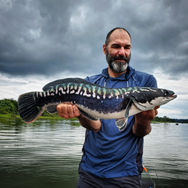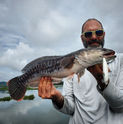Monsters Gallery
Monsters Gallery
TOMAN
The Giant Snakehead
Emblematic fish from Southeast Asia, the Channa micropeltes or Toman, is part of the Channidae family. It feeds mainly on fish, frogs but also worms and birds.
Its habitat can take multiple forms, lakes, rivers, reservoirs, submerged forests, canals, wherever vegetation is present and constitutes a hunting area.
Equipped with primitive lungs, it comes up to breathe on the surface, which allows it to adapt to stagnant or particularly turbid water.
When the water level increase, due to the rainy seasons, the fish start to group and turn to black color, annoucing that the spawning is nearby. The black toman are reputed to be the most powerfull.
After finding their partners, they will build their nest and mate. At this moments they turn into beautiful and intense colors, as yellow, green, blue or pink... Each fish has its own pattern.
After spawning, the adults take care of their young, the female more willingly remaining under the fry ball while the male circles around it. They will look after them during a few weeks, their colors slowly vanishing as the young grow until sepration.
Then the adults become lonely again. They are called "Bujangs", which mean lonely fish. This category of fish also turn in differents colors, mostly in purple tons. They are the ones who offer the famous top water explosion.
The toman can reach a weight above 15 kg for the biggest specimens, has impressive musculature and offers incredible defense. The average weight of fish is around 4 to 8 kg.
Expect last-second rushes and don't declare victory too quickly!
The Material
The rods :
* MH for fishing “bujangs - lone fish” with surface or subsurface lures. PE 1-3.
* H / XH most of the time when power, combativeness and environment require the use of a more authoritarian rod. PE 2-5.
We recommand to use travel rods in order to avoid additional costs for the flights but also to avoid the disappointment of not seeing your oversized luggage appear on the carpet at the airport of your destination.
The reels :
We recommand 150 or 200 sized reels with both correct recovery and a powerful brake to be able to extract fish from congested environments or prevent them from returning in the depth.
They will be garnished with braid in 40lbs and 50lbs as well as a 1 meter long fluorocarbon leader in 0.60 or 0.70 mm.
The lures :
* Crankbaits or longbill minnow able to quickly dive between 3 to 6 meters deep.
* Spinnerbaits about 30 to 50g, compact, with a strong iron hook, to track down the frei in the bush.
* Lipless / Vibes, heavy enough to quickly dive, 30 to 40g for open water.
* Stickbaits from 10 to 12 cm for top water.
* Soft plastic baits armed with a solid Texas hook for fishing edges and mats of aquatic vegetation.
* All lures rearmed with 3X hook (size 2 to 2/0) or single texas hook (size 8/0 to 12/0) as well as split rings with a minimum resistance of 65 lbs.
3 techniques
The blind cast :
This technique is requiere to chase for bujangs. Like power fishing, it consists of prospecting aquatic vegetation areas, by throwing soft plastic lures or jump frog and reeling in quickly. This technique requires a high ratio gear reel. Mastering skipping technique is a plus. The blinbcast is mainly used in the streams when the weather is too windy to fish the highways.
The sight cast :
As this fish often need to go up to breath, it's easy to spot them. This technique requiere speed and accuracy as you have a few seconds to cast at the right place to trigger the attack. The sightcast is mainly used early morning or in the evening, as it requieres not too windy conditions to be able to spot the rises. We also use it in sheltered bays. Stickbaits are perfect for this.
The fry ball stalking:
This technique is probably the most popular in Malaysia. It consists of finding a group of juvenils fish and trying to trigger an attack of the parents who are turning around to protect them from predators, as Hampala Barb, Aruan (common snakehead) or Peackok bass. This technics requiere observation and understanding of the fry ball behavior. The way they move, the shape of the ball, the size of the juvenils will provide informations to locate the parents. Which depth are they? How far are they from the ball? Is there one or two parents looking after? You will learn to read the fry ball to optimize your chance of catching them. If you are lucky, you can cacth both of the parents of the same freiball.
To outsmart them, you will use crankbaits, vibes as well as spinnerbaits.
Note that the juvenils always know where the parents are. It's not rare to see the fry ball coming to the boat or to the net when the fish is in. When we release it, it systematically finds its offspring.
Blind cast
Sight cast
Freiball stalking
The Toman's seasons




































